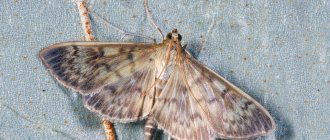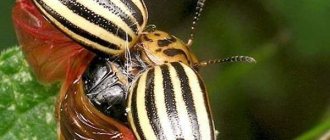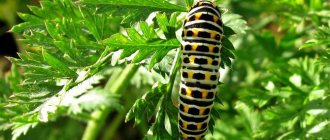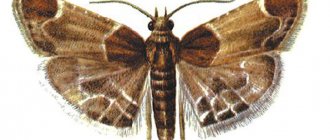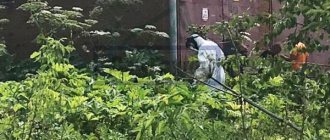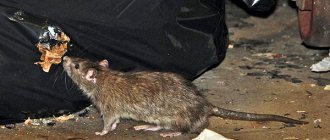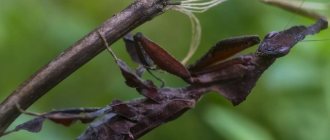Colorado beetle
This native of distant America, unfortunately, is familiar to absolutely everyone who grows potatoes. The striped aggressor from the family of leaf beetles really liked our climate. Beetles and larvae of the Colorado potato beetle feed on the leaves of representatives of the nightshades: potatoes, tomatoes, eggplants, which makes them dangerous agricultural pests.
- Which bugs in the garden should you definitely get rid of: top 7 pests
Unfortunately, many of the flying and crawling guests of your garden appeared on the site with not the best intentions. We study pest beetles.
This insect goes deep into the soil for the winter, and in the spring it comes out and begins to actively eat the first greenery. Even if you carefully monitor your plot, your potatoes are in danger. This insect actively moves, so it is not difficult for it to travel a hundred meters in the air from a neighboring infected garden to yours.
Plants damaged by the Colorado potato beetle simply dry out, because... lose their ability to absorb moisture and nutrients from the soil.
During a season, the pest can produce several generations (females lay eggs without interruption), and under unfavorable conditions, it can even hibernate for up to three years.
Appearance and symptoms of the presence of the Colorado potato beetle
Externally, the adult insect is a classic “beetle” up to 12 mm long, with a yellow head, a round body and shiny convex elytra with longitudinal stripes. Its larvae are about the same size, bright orange with a black head and two rows of black dots on the sides of the body.
Due to their similar appearance, the harmful larvae of the Colorado potato beetle are often confused with the larvae of the extremely beneficial ladybug. Be careful - the latter are gray, “spiny” with orange spots.
It is easy to detect the Colorado potato beetle; you just need to look closely at the potato leaves. On them (most often along the edges) you can easily notice characteristic traces of the presence of a beetle and its larvae: parts of the leaf have been gnawed off. The larvae feed by moving from the edge of the leaf to its center, gradually destroying the entire leaf blade. At the same time, if you turn over the whole leaves, you can see the beetle’s oviposition from below (many orange eggs tightly located to each other).
Measures to combat the Colorado potato beetle
It is not easy to fight the Colorado potato beetle and its larvae - the pest shows high resistance to poisons and quickly develops immunity to them, and is also poisonous to most birds and animals.
Preventive measures include strict adherence to crop rotation, annual deep autumn digging of the site, planting wormwood, calendula, onions, and hemlock near the potato beds.
If insects have already appeared, you will have to try very hard and apply comprehensive measures. This includes manual collection of beetles and larvae with their destruction outside the site, placement of traps with potato peelings, treatment of crops with folk remedies (birch tar solution, a mixture of soap and ash), as well as the use of chemical insecticides (Fitoverm, Aktara, Corado, Golden Iskra, etc. .P.).
- Which remedies for the Colorado potato beetle to choose - a review of popular drugs
Many people collect the Colorado potato beetle by hand. But what if the area is large and there are a lot of insects? Use chemicals!
Causes of pests
The rich nutritional content of potatoes attracts insects. Pests eat not only tubers, but also potato tops; in addition, they are carriers of dangerous diseases. As a result of the harmful activity of insects, potatoes stop developing and may die. Damaged fruits are unsuitable for storage.
How to Grow Healthy Potatoes from Seeds
The reasons for the appearance of pests in a potato field can be as follows:
- crop rotation was disrupted, that is, crops were grown in one place for a long time;
- the insects were in the soil, during digging they crawled out and waited for the potatoes to ripen;
- you planted low-quality tubers or tubers infected with larvae.
If pests appear in the garden, it is necessary to immediately take measures to destroy them.
- Miner / Mine
Medvedka
This large omnivorous insect is sometimes popularly called “earthen crayfish” for the shape and size of its front legs. Mole cricket is dangerous for absolutely all plants in the garden. This pest eats or damages root vegetables, potatoes, roots and bulbs of flowers, shrubs and trees. Both adults and larvae are capable of digging their burrows near plant seedlings and dragging them underground to eat.
An insect can enter a site either on its own or with imported fertilizer or soil. The mole cricket leads an underground lifestyle, eating everything it comes across on the way to digging its passages and holes. It also overwinters in the soil, in the spring it lays eggs in earthen chambers, and after a couple of weeks larvae are born, which will develop for several years.
The mole cricket reproduces quickly, laying one and a half to two hundred eggs at a time, and quickly gets used to pest control medications.
Appearance and symptoms of the presence of a mole cricket
An adult mole cricket is a large (up to 5 cm) big-eyed brown-brown insect with large front paws-claws. She runs fast, moves actively underground, and can fly and swim.
Mole cricket larvae are similar to adult individuals, only smaller in size and slower. As they grow, they feed on the same resources, increasing trouble in the garden beds.
The appearance of a mole cricket in an area can be detected by the sudden wilting of seedlings and the surface of the soil, dotted with small holes and loose mounds that appear in places where the insect moves.
Measures to combat the mole cricket
Measures to prevent the appearance of mole crickets include planting plants with a strong smell (marigolds, calendula), sifting purchased soil and manure, and following the rules of agricultural technology.
If insects have already appeared on the site, you will have to fight them - and, unfortunately, this will take quite a long time. Some even believe that it is impossible to completely remove mole crickets from the garden.
You can place a variety of traps on the territory (containers with beer or honey, piles of manure). Boiling water, an infusion of onion peels or soapy water are poured into the discovered holes made by mole crickets in the ground, or calcium carbide is poured (after rain it will enter into a chemical reaction with water, releasing acetylene gas, which is poisonous to the insect).
Of the proven chemical insecticides against mole crickets, we can recommend Terradox, Discharge, Medvegon, Grom, Rubezh, Rofatox, Rembek, etc., which are laid out in holes during planting of seedlings.
- How to deal with mole crickets - effective drugs and folk remedies
Don’t know how to get rid of mole crickets on your property? Our recipes will help you protect your garden crops from this underground pest.
Pest Control Methods
The following methods using various means will help you get rid of the listed pests on potatoes: chemicals, manually and folk remedies.
See also
Instructions for using the remedy for the Colorado potato beetle Komandor
Read
Mechanical methods of struggle
Mechanical methods of control involve manual collection of pests from the surface of potatoes. For example, gardeners collect the Colorado potato beetle or potato wedges. This is, in some way, an effective technique that requires a lot of effort and time. Collection can be done with large specimens that will not fly away due to human presence. The same cannot be done with earth-moving insects.
The latter can be destroyed with the help of deep digging in autumn and spring. Knowing at what depth insect larvae and eggs are located, people use various types of plowing in their garden. In this case, eggs and pupae turn to the surface, and under the influence of frost they die.
In addition, in the fall, be sure to remove weeds from the area where pest oviposition may persist.
Vegetable storage facilities into which eggs may end up along with the potato harvest are treated for the same purposes. For warm regions where chafers fly en masse, they are caught by turning on the lights and catching them at night using various devices, such as nets made of small fabric. By nature, beetles fly towards the light, which makes them easier to catch.
In the fight against rodent pests, homemade traps and traps are used. Ultrasonic repellers are installed along the perimeter of potato plantings and are effective. They use smoke blowers and sulfur bombs, which are lowered into the burrows. And ultimately, they attract cats and dogs.
Chemicals
The use of chemicals to kill pests is the most effective method of control, especially in cases of massive infestation of potato plantings. The most effective are:
- You cannot use the same product against the Colorado potato beetle every year, as this causes the pest to become addicted. To destroy it, use: “Colorado”, “Iskra”, “Marshal”, “Taboo”, “Sumitsidin”, “Prestige”, “Decis”, “Temp”, “Glow”.
- To etch cutworm caterpillars, Zolon, Prestige, Inta Vir, Dursban and Danadim are used both on the surface and inside the soil.
- To eliminate oviposition, the mole cricket and its planting itself are treated with “Medvetox” and “Medvecid”. Many gardeners resort to the help of “Fenaskin +”, “Regent”.
- Such work is not carried out against wireworms due to its low effectiveness.
- The following chemicals can defeat the nematode: “Bi 58” and “Dimethoate”.
- Rodents can be exterminated using disinfectants sold at any veterinary pharmacy.
Typically, the listed insecticides have a wide spectrum of action, that is, they destroy a group of pests. If in the proposed list the product is presented for the Colorado potato beetle, it can be used to treat other pests on potatoes. All actions must be coordinated with the attached instructions: dose, quantity for different types of crops, type of insects, method of preparation and hazard class.
Traditional methods
It is not always good to use chemicals. Many fighters for a healthy lifestyle will use all available and studied means at hand, which are no less fruitful:
- The Colorado potato beetle, like many other pests, does not like the aroma of some herbs: marigolds, calendula, parsley, and other aromatic herbs. It is recommended to place flower beds with these flowers close to the potatoes. Today this is most likely a myth, since over the years the beetle has even become addicted to certain chemicals. An infusion of wormwood is used as a treatment. The herb is crushed, poured with boiling water and infused, and then watered or sprinkled over the potato leaves.
- To save potatoes from flea beetles, use ash, tobacco dust as a pollinator, and a solution of food salt under the bush. It is more effective to prepare a mixture including these components with the addition of chamomile infusion.
- Some pests do not like onions and garlic, so by sprinkling the potatoes over the leaves with an infusion of the products, you can drive away the pests, bugs and the same flea.
- The mole cricket does not tolerate fatty or high soil fertility, so an infusion of chicken manure will drive it out of the garden. Take 2 kg of litter in a bucket of water and let it sit. The working fluid consists of 1 part infusion and 5 parts water. Only spill the infected areas under the potatoes.
- It is also recommended to treat potato tubers with potassium permanganate before planting, which will reduce the percentage of damage by nematodes and wireworms.
In the fight against wireworms, it is important to select potato varieties that are resistant to the pest.
Click beetle and its wireworm larva
Strictly speaking, there are many species of click beetles. And not all of them are dangerous for your garden. But we will talk specifically about the latter, which themselves feed on young tubers and leaves of potatoes, and lay eggs, from which real dangerous pests of agricultural crops emerge - larvae, nicknamed wireworms for their appearance.
The beetles lay their eggs in the soil in early to mid-summer, and the hatching larvae overwinter several times before pupating and developing into adult insects, becoming especially harmful to plants when they are older.
Wireworms gnaw long straight passages in tubers. Damaged plants become easy prey for parasites and diseases, are practically impossible to store, and lose their marketable appearance. If wireworms dominate the area, it is impossible to grow healthy root crops even with the use of strong chemicals.
Appearance and symptoms of wireworm presence
The beetles themselves are brown insects with an elongated body, clearly divided into a cephalothorax and abdomen. They received their name for their remarkable ability, being turned on their back, to independently turn over with a jump with a sharp clicking sound.
The beetle larvae are small, dense, yellow-white “worms” that darken with age to an orange-brown color with a dark head and a hard, chitinized cover. During the growth period, wireworms actively move in search of food and feed on underground plant organs.
It is quite simple to determine whether an area is infested with these larvae by the presence of tubers damaged in this way.
Measures to combat wireworms
The fight against wireworms begins with prevention: do not thicken the crops, observe crop rotation, promptly remove weeds (especially wheatgrass) and plant debris, lime the soil, preventing it from acidifying and caking.
Biological methods of getting rid of wireworms mainly include installing traps and baits based on natural products. Every day, the containers need to be cleaned of accumulated larvae and “charged” again, and this will have to be done all summer. You can also use folk remedies to repel pests - onion peels, mustard powder, pine needles, potassium permanganate, etc. A good result is achieved by introducing predatory ground beetles into the area, if possible.
If the number of wireworms is too large, you can treat the soil against pests with chemicals (Zemlin). However, it is not recommended to plant anything in the treated area for some time.
- 10 ways to deal with wireworms
Find out what wireworm looks like and how to effectively fight it.
Prevention of potato pests
Vegetable growers have to constantly fight potato pests. But prevention is the most effective option against potato parasites on the site. You need to start protecting the crop with planting material. There is a large selection of drugs. They differ in their operating principle, price, volume, and degree of danger. Ways to use protective equipment:
- Processing potato tubers before planting. You can take “Prestige” or “Taboo”. The drug is applied directly to the tubers or the solution is added to the wells. A solution of potassium permanganate or wood ash is a substitute for chemicals.
- Deep plowing of the site in the fall. This technique destroys the larvae of pests that have gone to winter.
- Hilling up, high-quality weeding of potatoes. Hilling the tops does not allow many parasites to reach the bush; loosening the soil at this moment destroys young individuals. Weeding gets rid of weeds that serve as habitats or breeding grounds for many pests.
- Growing plants with a repellent odor along the edges of potato beds - marigolds, dill, basil.
- Add 0.5 cups of wood ash to the holes to repel insect pests.
It should be noted that you should not limit yourself to one method; you need to fight comprehensively.
Some visual information:
Potato moth (fluorimea)
The potato moth is a historical neighbor of the Colorado potato beetle. In its homeland in America, it (or rather its caterpillars) has long been, since the times of ancient Indian civilizations, damaging potato tubers stored for storage. And only in the twentieth century did it “enter the world stage.”
This quarantine pest is nocturnal as an adult. The moth lays eggs on the underside of plant leaves (mainly from the Solanaceae family); the eggs hatch into larvae that begin to actively gnaw on the leaf blades. When the potato tops dry out, the caterpillars descend into the tubers and literally tear them up from the inside.
The pest overwinters in the open air in the form of an imago or pupa under plant debris in the upper layers of the soil, as well as in tuber storage facilities - at all stages of development.
The main reservoir of potato moths is precisely potato storage facilities, where insects actively continue their development, damaging tubers and thereby contributing to their rotting.
Appearance and symptoms of potato moth
An adult moth insect is a small butterfly of an inconspicuous brownish-gray color with long antennae and a wingspan of up to 15 mm. The active period is from April to October.
One female during her short life (just a few days) can lay up to 200 eggs, from which yellowish caterpillars emerge, reaching 13 mm in length in the last stages. The pupae are brown, enclosed in silver-gray cocoons.
In case of massive infestation, it is not difficult to notice traces of the presence of potato moth - the leaves of the plants in the beds are nibbled, the tops are drooping, the stems and leaves are shrouded in a white “web” (mainly in the upper part), the tubers are deeply penetrated by winding passages.
Measures to combat potato moth
Prevention and biological control measures against potato moth include the use of only healthy planting material, destruction of weeds, timely high hilling of bushes, harvesting before the tops dry out, storing only healthy undamaged tubers, as well as spraying vegetative plants with Entobacterin (50- 100 g per 10 liters of water) with an interval of 6-8 days.
Chemical measures - after detection of butterflies, immediate treatment of potato bushes with preparations: Inta-Vir, Inta-Ts-M, Molniya Extra, Shar Pei, etc. The interval between treatments is 10-15 days.
The most dangerous potato pests
The spread of pests in the garden most often has the nature of an epidemic, that is, one type of insect is active one year, and another the next year. If appropriate pest control and prevention measures are not taken, you can lose up to 40% of the harvest.
Most potato pests are highly resistant to climate change, so it is difficult to destroy them using natural methods. When the same product is used against insects for a long time, it also becomes addictive, and in the future such a drug becomes completely useless.
Protecting a potato field from insects and other pests should include a set of certain measures. But in order to carry out the most effective fight against parasites, it is necessary to first study their biological abilities, characteristics and nature of life.
Colorado beetle
The most famous and very dangerous pest of potatoes is the Colorado potato beetle. When spread en masse, the insect can destroy the entire crop of root crops.
The homeland of the Colorado potato beetle is Colorado. For the first time, residents of the state discovered the beetle in 1859. After 100 years, the insect safely “moved” to Russia. Until 1975, agronomists managed to successfully combat the spread of the pest, but after a few years the Colorado potato beetle spread throughout many countries of the world.
Description
The striped body of the Colorado potato beetle is visible even to the naked eye. The insect is small in size - up to 1 cm in length and up to 0.7 cm in width. The surface of the body is dense, orange in color. The body has hard elytra decorated with black longitudinal stripes. Soft wings are located under the hard elytra.
The greatest damage to root crops is caused by the bright orange larvae of the Colorado potato beetle. The larvae emerge from eggs that the adult insect lays on the underside of potato leaves. The larvae are very voracious, they feed on the juicy pulp of leaf blades and cause significant damage to plants.
Biological features
The Colorado potato beetle overwinters underground. It burrows into relatively shallow holes (up to 10 cm), and in the spring, after persistent warm weather appears, it emerges to the soil surface.
The female beetle is fertile. During the summer season, it is capable of laying 3 generations of larvae. The total number of eggs laid per season often exceeds 1000 (provided that the weather is warm but not hot).
The larvae feed on tops. If you do not fight pests, they are able to gnaw off the green pulp of plants completely. Having eaten, the larva burrows into the soil, where it pupates, and after 2-3 weeks an adult beetle crawls to the surface. If the summer season is over, then the adult goes to winter. If summer is in full swing, then the pest again begins to destroy potato tops.
The insect prefers to feed on young agricultural tops. If young potato leaves are destroyed, the pest moves to eggplants, tomatoes and other plants.
Control measures
The most ancient way to combat the Colorado potato beetle is to collect adults and larvae. Potato tops are regularly inspected, pests are collected and destroyed. The method is effective if the insect’s spread has just begun and its numbers are small.
If the Colorado potato beetle has “captured” most of the potato field, then it is necessary to use other methods. Insecticides are used to treat tops. The drugs can be purchased at a specialty store. It is recommended to carry out 2 treatments per season, this will guarantee the destruction of the Colorado potato beetle. It is important to remember that insecticidal preparations can accumulate in plants, so when using them you must adhere to the basic instructions for use and not exceed the dosage specified in the recommendations.
Insecticide preparations for the Colorado potato beetle:
- Fitoverm;
- Karate;
- Zolon;
- Colorado;
- Sonnet.
Traditional methods
- Sprinkle the soil and potato tops with wood ash, gypsum, cornmeal or pine sawdust. After this, the surface of the plants will be covered with a thin but dense shell, which the beetles cannot gnaw through. The result of the event will be the movement of the pest to other territories. The disadvantage of this method is that agricultural crops must be processed regularly, preferably in the early morning, when dew remains on the plants. After rain, the treatment must be repeated, since the moisture will wash away the protective film, and the beetle will again begin to destroy the tops.
- Spray the plants with infusions or decoctions based on “specifically-smelling” herbs - garlic, tansy, onion peels, calendula, etc. An analogue of this method is spraying a potato field with an infusion of hot pepper, an alcohol solution, tobacco or birch tar. The disadvantage of the procedure is the need to repeat the treatment at least 3 times a week and always after rain.
Wireworm
Wireworm is one of the most dangerous potato pests. It spoils the tubers by gnawing holes in them. In addition, wireworms are a carrier of bacterial, fungal and viral diseases, which, when spread in the soil, can destroy the entire crop.
Description
The wireworm is a beetle with a black hard body, which is 5 cm long. Another name for the pest is the click beetle. It earned its name thanks to the characteristic sound (clicking) that it makes if the beetle is turned over on its back.
Wireworm larvae are similar in external parameters to worms; their body is long, thin, and yellow in color.
Pest larvae are very voracious. They are able to gnaw through potato tubers. Through holes left by wireworm parasitism are a favorable environment for the proliferation of pathogenic microorganisms.
Biological features
Adult click beetles overwinter in the soil, burrowing into the surface layers. In the spring, the beetle lays eggs, from which larvae subsequently hatch.
The larva of the click beetle is a long-lived pest among other pests. It is capable of parasitizing in the soil for 5 years, regularly causing damage to potato tubers. In winter, the larvae hide in the deep layers of the soil; in the spring, young click beetles form from the grown pests.
Control measures
If the wireworm has just settled in the garden, then an effective method would be to dig up the potato plot and collect the pest manually. The method will not be effective if the pest has settled in the area. In this case, it is recommended to use the following methods:
- Add nitrogen-containing fertilizer to the soil - ammonium sulfate (30 g/1 sq. m.), ammonium chloride (30 g./1 sq. m.) or ammonium nitrate (20 g./1 sq. m.). The unpleasant smell of nitrogen will repel the pest.
- Soil treatment with special preparations - Aktara, Bazudin, Prestige, Provotox, Grom, Pochin. The active components of the drugs are chemical compounds, so disinfection is allowed only in extreme cases, when the number of wireworms is huge.
- Treatment of plants and soil with a biological preparation - Nemabact.
Traditional methods
- Spraying and watering the soil with a slightly pink solution of potassium permanganate;
- watering the potato field with a decoction of herbs - dandelion, coltsfoot, nettle;
- spraying and adding onion peel decoction to the soil;
- sowing between potato rows annual flowers with specific aromas - marigolds or calendula.
Khrushchev (chafer beetle larva)
Voracious and dangerous potato pests. The larvae of the cockchafer live underground and absorb everything they come across - from tree roots to root crops. Therefore, the pest poses a significant danger to plants in the garden and garden.
Description
The length of an adult larva reaches 4 cm. Its body is light brown, curled into the shape of the letter “C”. The head is small and dark. The surface of the body is covered with thin fluff. There are 3 pairs of thoracic legs and 5 pairs of abdominal legs on the body.
Biological features
Even one beetle larva that has settled in a potato field can negatively affect the yield. Fortunately, “raids” of beetle larvae on plants occur once every 10-15 years.
May beetles appear in early to mid-May. At this moment, individuals feed on young foliage, but their main goal is to produce offspring. 6 weeks after laying, the eggs hatch into larvae. They spend up to 4 years in the soil, gradually growing into an adult insect. Throughout the years, the larvae feed on root crops and plant roots, reducing productivity.
Control measures
An effective agrotechnical measure is the collection and destruction of larvae during digging of the site. Khrushchev larvae do not settle next to enemy plants - fennel, coriander, anise, cumin, dill. Therefore, if the listed plants are planted between potato rows, this will become an effective prevention against the spread of the pest.
In case of significant damage to a potato field by Khrushchev larvae, it is recommended to use chemicals - Pochin, Aktara, Vallar, Zemlin, Bazudin, Antikhrushch. Follow safety rules during processing.
Biological preparations against beetle larvae - Nemabakt, Boverin, Actofit, Fitoverm.
Traditional methods
- Khrushchev larvae cannot tolerate the smell of nitrogen, so adding nitrogenous fertilizers to the soil will get rid of the pest.
- Water the soil with a solution of ammonia (1 tablespoon of active agent per 10 liters of water). Treat every 2-3 weeks.
- Water the soil and spray the potatoes with a concentrated decoction of onion peels (100 g of peels per 1 liter of water). Carry out the treatment 2 times with an interval of 2 weeks.
Nematode
Potato root nematode is the most dangerous enemy of agriculture. The pest parasitizes the roots of the plant, which makes it difficult to detect it in a timely manner. The spread of the nematode leads to the death of the plant and, accordingly, to loss of yield.
Description
Visually detecting a nematode is almost impossible. The parasite is less than 1 mm. Its body looks like a thin little worm, white or gray in color.
Nematodes are numerous, so they cause significant damage to plants.
Biological features
Root nematodes parasitize the roots of the plant, so tubers do not develop on the “sick” crop. If tubers do form, they grow small, twisted, and ugly.
Tuberous nematodes gnaw through root crops; the result of parasitism is the formation of small black spots. Stem nematodes attack leaves and stems of crops. A “sick” plant begins to bush and branch, but does not bear fruit.
Control measures
Nematodes are very difficult to control. To reduce the number of pests, it is recommended to use the following preventive measures:
- Do not plant potatoes in one place for several years in a row. It is recommended to leave an interval of 4-5 years between plantings.
- For planting, choose nematode-resistant potato varieties - Rosara, Skarb, Zhuravinka, Atlant, Veras, Lazurit. Alternate sowing varieties in one area every 3 years.
- Avoid accumulation of plant debris on the site. In the fall, after harvesting, remove the tops and remains of root crops.
- In early spring and after harvesting in autumn, water the plots generously with urea.
- If the area is severely affected by nematodes, treat the soil with the chemical Thionasin 6 weeks before sowing potatoes.
Medvedka
Another dangerous potato pest. The mole cricket is a pest that lives underground and looks different from other insects. The mole cricket feeds on root crops and, when widespread, can destroy more than half the crop.
Description
The mole cricket has external characteristic features that greatly distinguish it from other insects. The pest has a body size of up to 5 cm in length. The body surface is dense, brown in color, the abdomen is light. The mole cricket has wings, but despite this it very rarely flies, preferring to spend most of the day underground.
The body of the mole cricket is divided into 2 parts. The front part is in the form of a shell; it can pull its head into it. The back of the body is soft. The head is small, equipped with a powerful oral cavity, capable of chewing through hard and dense surfaces and crushing plants.
The mole cricket has 3 pairs of legs. The front legs are powerful and designed for digging. The insect spends the day in the ground, digging tunnels and arranging nests. At night, it often climbs to the surface of the soil.
Biological features
The mole cricket is distributed throughout most of Russia, but more often prefers to settle in warm and humid areas. The insect can absorb any plant food, not just potatoes.
The pest nests deep in the soil. The female builds a nest and lays 200 eggs in each. During the season, the insect is capable of hatching 2-3 generations of larvae. The maturation of the larvae lasts 2-3 weeks, after which time they become dangerous for garden plants.
The mole cricket causes significant damage by digging underground passages. With its activity, it disrupts the root system of plants, which often leads to their death.
Control measures
Destruction of mole cricket burrows and passages is an effective way to combat insects. Another method of destroying the pest is deep plowing of the potato field during the period of autumn frosts.
The insect does not like specific odors, so it is recommended to plant marigold bushes between the ridges in the potato plot.
Traditional methods:
- Prepare bait: mix crushed shells with a small amount of vegetable oil. Roll small balls and place them in the mole cricket's passages and holes. While absorbing the bait, the insect's airways will become clogged, which will provoke its death.
- Placing traps on an area is an effective method of controlling a small population of mole crickets. Making a trap: pour sunflower oil or beer into a glass jar. Bury the jar in the ground, leaving the neck on the surface. The smell of the bait will make the mole cricket crawl into the jar, and it will no longer be able to get out of it. The gardener will only need to regularly collect insects from the jar and destroy them.
If the pest spreads significantly, it is recommended to use chemicals - Prestige, Grom, Medvetoks, Aktar.
Potato moth
The life of potato moth lasts about 2 weeks. But during this period, she manages to lay more than 200 eggs, from which voracious caterpillars subsequently hatch and are capable of destroying most of the potato crop.
Description
The appearance of an adult potato moth is quite unsightly - it is a small gray insect with terry wings. When a butterfly folds its wings on its back, their pattern forms elongated dark stripes. This feature distinguishes the potato moth from other insects.
The offspring of moths are transparent or yellowish larvae, the body length of which is no more than 1.5 cm. Moth larvae are very voracious. They feed on the juicy pulp of tubers.
Biological features
Damage to potato plantings is caused by the potato moth larva. If an adult insect lives no more than 2 weeks, then the larva, in conditions favorable to it, can live and parasitize for six months.
The moth larva is a dangerous enemy for agriculture. If it is not destroyed in a timely manner, then the increased number of the pest can destroy the entire crop of root crops.
Low air temperatures are detrimental to the larva, so if the potato tubers are frozen, the pest dies naturally.
Control measures
It is not possible to get rid of potato moth using traditional methods. If signs of insect pests appear on the site, it is recommended to treat the plants with chemicals - Dendrobacillin, Bitoxibacillin, Leptocide. Spraying of plants must be carried out strictly before the formation of ovaries.
Potato aphid
Aphids cause damage to potato plantings. The spread of the pest in the garden is fraught with the destruction of the entire harvest of fruit and berry crops.
Description
Several types of aphids can parasitize potatoes: peach aphid, large aphid, and potato aphid. It is difficult to detect the pest with the naked eye - it has a small (2-3 mm) body, colored green, transparent or white.
Biological features
Favorable conditions for the life of aphids are sunny, warm weather and high air humidity. Aphids form numerous colonies that settle on the lower part of plants (near the trunks) and on the back side of leaf blades. The pest is voracious and can completely destroy the green foliage of a plant in a few weeks.
The danger of aphids lies in the fact that they are carriers of viral and bacterial diseases. When a potato field is infected by pathogenic microorganisms, the risk of crop loss is very high.
Control measures
To destroy an aphid colony, it is necessary to use a set of appropriate measures:
- do not allow potatoes to be planted in wintering areas of the pest;
- plant early potato varieties that are resistant to climate change;
- regularly destroy weeds and plant debris between the ridges;
- get rid of anthills on the site;
- in case of strong spread of parasites, treat plants with insecticidal preparations - Aktara, Fitoverm, Prestige.
